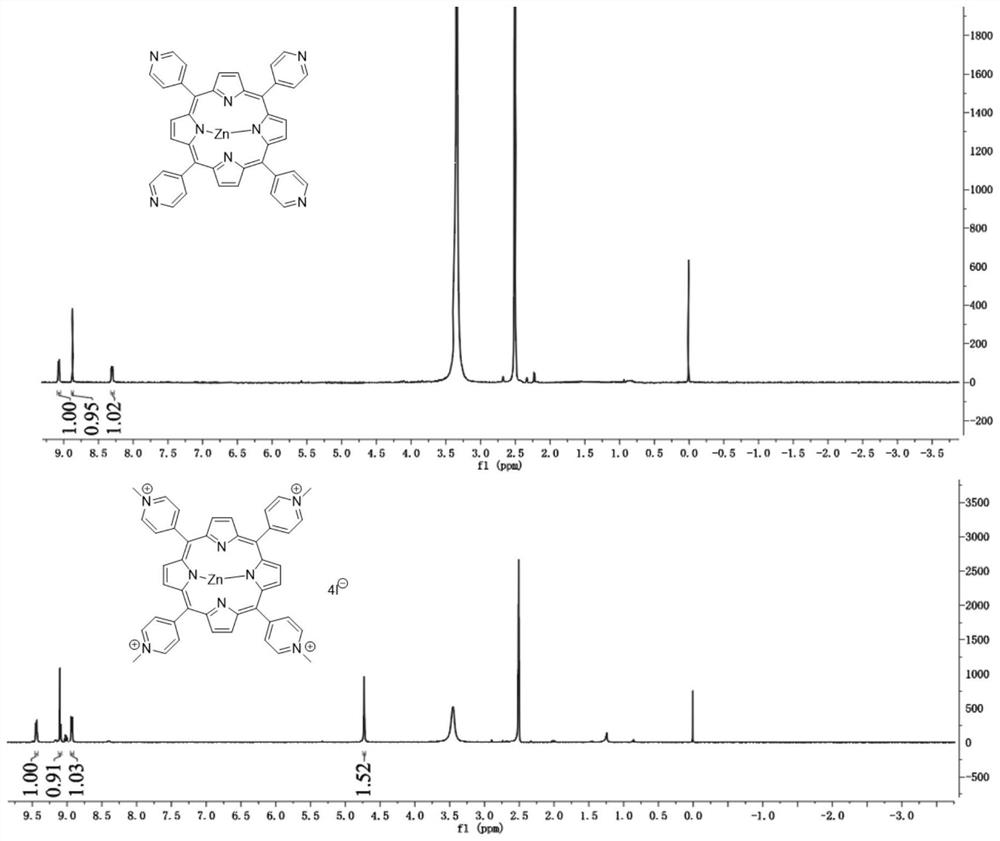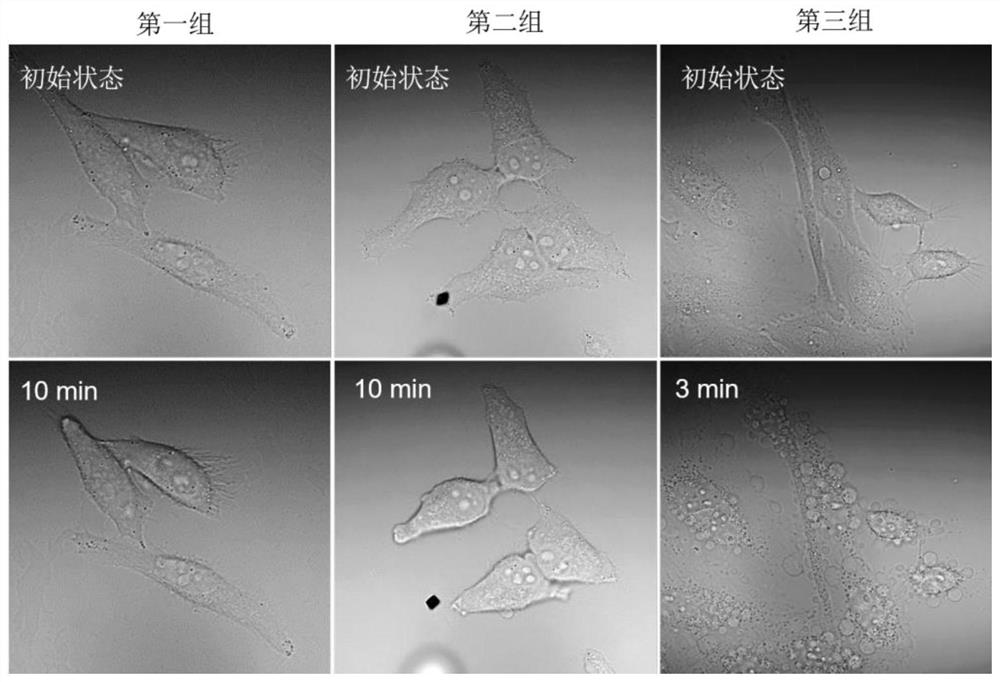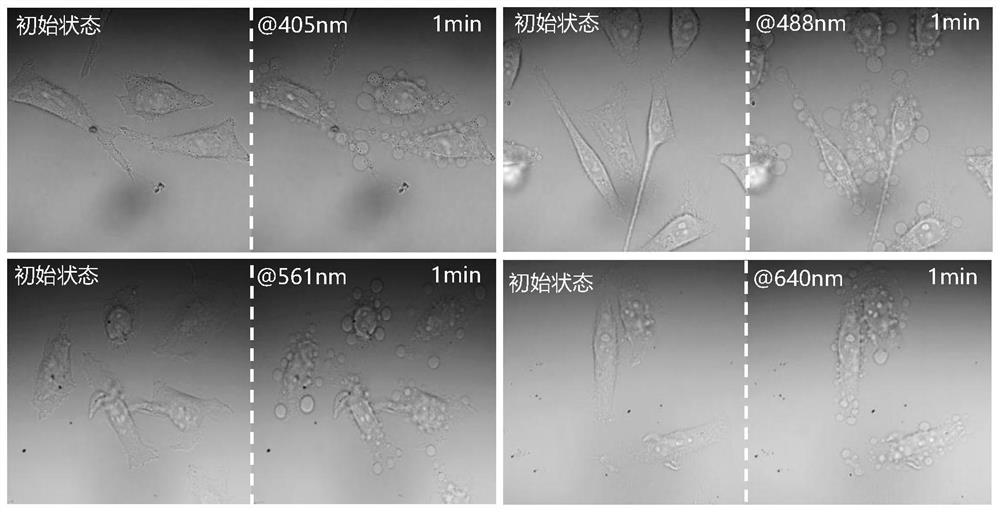Porphyrin tetraazacyclo-based light-controlled pyroptosis material as well as preparation method and application thereof
A technology of tetranitroheterocycles and nitrogen heterocycles, which is applied in the field of light-controlled pyroptotic materials and its preparation, can solve the problems of short excitation wavelength, high light source energy, and small penetration of photopyrotic materials, and achieve rapid Effects of light-controlled pyroptotic properties, good biocompatibility, and cheap and easy-to-obtain raw materials
- Summary
- Abstract
- Description
- Claims
- Application Information
AI Technical Summary
Problems solved by technology
Method used
Image
Examples
Embodiment 1
[0028] Embodiment 1, the synthesis of photopyrotic material
[0029] Below with X=I, Z=Zn is a typical molecule, and its synthetic route is shown in the following formula:
[0030]
[0031] Specific steps are as follows:
[0032] (1) Preparation of compound 1
[0033] First, dissolve 0.4g of zinc acetate in 3mL of methanol solution, dissolve 0.8g of 5,10,15,20-tetrakis(4-pyridyl)porphyrin in 150mL of chloroform solution, mix the two, heat to reflux and Stir the reaction for 30 minutes; after the reaction, wait until the temperature drops to room temperature, extract at least twice with deionized water, collect the organic phase solution, add a large amount of anhydrous sodium sulfate to it to absorb excess water; filter to obtain the supernatant, and spin evaporate the organic phase solution. Solvent, to obtain a dark brown solid is compound 1;
[0034] (2) Preparation of compound 2
[0035] Compound 1 was dissolved in a mixed solution of an appropriate amount of meth...
Embodiment 2
[0039] Example 2, the difference between molecules before and after demethylation
[0040] Take compound 1 and compound 2 respectively, and use the complete culture solution to prepare the concentration of 10 -5 M's solution. A total of three groups of Hela cells were set up, wherein the first group of cells was directly cultured with complete culture medium for 12 h, as the blank control of the first two groups, the second group and the third group of cells were co-cultured with compound 1 and compound 2 solutions for 12 h respectively, and the three groups All culture conditions of the cells were the same. The morphological changes of the three groups of cells under 640nm laser irradiation were observed by laser confocal and compared. It can be seen that after 10 minutes of laser irradiation, the cells of the second group shrank significantly compared with the cells of the first group ( figure 2 ), which is a typical phenomenon of apoptosis, indicating that compound 1 ha...
Embodiment 3
[0041] Example 3, multi-wavelength photo-induced pyroptosis
[0042] Take compound 2 by 10 -5 M concentration was added to Hela cells for culture, and the morphological changes of cells under different wavelength lasers were observed by confocal laser. In the initial state, the cells have a normal irregular shape. With the change of the wavelength of the laser confocal laser (405nm, 488nm, 561nm, 640nm), it can be seen that under the laser of each wavelength, the phenomenon of "bubbling" on the cell surface can be observed after 1 minute, that is, it will start to occur. pyroptosis ( image 3 ). This shows that the material synthesized in the present invention can realize multi-wavelength photopyrotoxicity from ultraviolet light to visible light.
PUM
 Login to View More
Login to View More Abstract
Description
Claims
Application Information
 Login to View More
Login to View More - R&D
- Intellectual Property
- Life Sciences
- Materials
- Tech Scout
- Unparalleled Data Quality
- Higher Quality Content
- 60% Fewer Hallucinations
Browse by: Latest US Patents, China's latest patents, Technical Efficacy Thesaurus, Application Domain, Technology Topic, Popular Technical Reports.
© 2025 PatSnap. All rights reserved.Legal|Privacy policy|Modern Slavery Act Transparency Statement|Sitemap|About US| Contact US: help@patsnap.com



